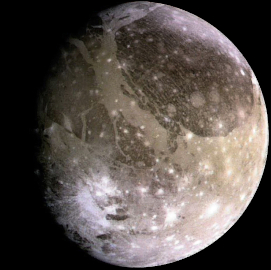Psalm 19:1
“The heavens declare the glory of God; and the firmament sheweth his handywork.”
 There are many strange worlds in the Solar System. Ganymede is one of Galileo’s moons – one of the four larger moons of Jupiter, discovered by pioneering astronomer Galileo Galilei. In fact, Ganymede is the largest of Jupiter’s moons, with a diameter of 3,280 miles – which makes it larger than the planet Mercury. However, it is less dense than Mercury, having an average density of 1.936 g/cm3. The reason is that Ganymede appears to consist of a smaller rocky body covered with an underground ocean and an outer crust of ice. Although not directly observed, the Hubble Space Telescope has recorded measurements on how aurorae move over the body’s surface that seem consistent with an underground ocean.
There are many strange worlds in the Solar System. Ganymede is one of Galileo’s moons – one of the four larger moons of Jupiter, discovered by pioneering astronomer Galileo Galilei. In fact, Ganymede is the largest of Jupiter’s moons, with a diameter of 3,280 miles – which makes it larger than the planet Mercury. However, it is less dense than Mercury, having an average density of 1.936 g/cm3. The reason is that Ganymede appears to consist of a smaller rocky body covered with an underground ocean and an outer crust of ice. Although not directly observed, the Hubble Space Telescope has recorded measurements on how aurorae move over the body’s surface that seem consistent with an underground ocean.
Evolutionary scientists are very excited about the prospect of this subterranean ocean. They suppose that life on Earth evolved from a sort of soup at the bottom of the ocean, possibly near ocean floor vents. By analogy, scientists hope to find similar vents under Ganymede’s ocean, should it exist. This makes Ganymede the current favorite in the supposed possibility of organic evolution happening somewhere else in the universe.
The magic word for evolutionists is “millions of years”. Evolution of single-celled creatures from a primordial soup has never and will never be possible. Yet, transport the alleged event to another world, and it is supposed that it could have happened because of the long ages required. The unusual world of Ganymede does not contradict the account in Genesis of how God made everything.
Prayer: Your Word is true from beginning to end, Lord God. Thank You for creating this universe and for the beauty and wonder of that creation. Amen.
Author: Paul F. Taylor
Ref: Encyclopaedia Britannica, < https://www.britannica.com/place/Ganymede-satellite-of-Jupiter >, accessed 8/31/2019. Image: Public Domain.
© 2020 Creation Moments. All rights reserved.
